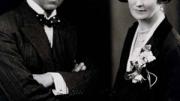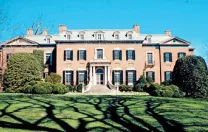Robert Bliss died in 1962, Mildred Bliss in 1969, but the benefactors of Dumbarton Oaks still cast a long shadow over their former home. It’s not just that the Blisses left behind their home and all their belongings. The estate’s later caretakers have inscribed their words on plaques; staff members mention their names frequently; and people occasionally report seeing Mrs. Bliss walking about in the gardens. Indeed, the estate’s very name comes from the Blisses, who combined its first recorded name—taken from the Rock of Dumbarton in Scotland, the homeland of early owner Ninian Beall—and a name from a later period, when it was called simply “The Oaks.”
Robert Woods Bliss, A.B. 1900, a career diplomat, and Mildred Barnes Bliss, heiress to a laxative fortune and the niece of Edith Wharton, had spent two decades overseas during his postings to Venice, St. Petersburg, Brussels, Buenos Aires, Paris, and the Hague. In 1920, they were looking for a home base in Washington, but they also had grand aspirations for their estate. They envisioned a place for scholarly studies and musical performances, and a home for the fine art and ancient artifacts they had assiduously collected. And they had notions of eventually giving all of it to Harvard.
A history of Dumbarton Oaks records Robert Bliss’s words upon seeing the property for the first time: “though it had no particular charm and the grounds were unkempt and in places much overgrown, the beautiful trees gave promise of possibilities to a gardener.” Beall’s Georgetown estate had been divided up and sold to different owners over the years; the Blisses reassembled several parcels into their own 53-acre plot.
They made their gift to Harvard sooner than they had originally planned. In 1940, as World War II consumed Europe and threatened to draw in the United States, they turned over to the University 16 acres, including the main house, gardens, and their collections and library. “Dumbarton Oaks is now ready to increase its contribution to the intellectual life of the nation,” Robert Bliss told the Washington Times-Herald. They also gave 27 acres to the National Park Service, which made the land into Dumbarton Oaks Park, and sold 10 acres to the Danish government for an embassy complex. They had lived at the estate only since 1933, and for just 10 years in all, having bought it while Robert Bliss was on a domestic posting, before being sent to Sweden and Argentina.
With the gift, Harvard received 1,200 Byzantine objects, as well as 17,000 Byzantine coins and 800 pieces of pre-Columbian art. The Blisses “had no aspiration to be scholars, but they had quite good taste,” says Dumbarton Oaks director Jan M. Ziolkowski. “Collecting was a serious business for them.”
Many have noted similarities to I Tatti, the estate near Florence that was left to Harvard in 1959 by Bernard Berenson, A.B. 1887, as a center for Renaissance studies. Besides a research library, that estate offers artworks, gardens, and olive groves—a set of resources for well-rounded scholars of the humanities. The I Tatti gardens feature pebble mosaics; Mildred Bliss converted a former tennis court at Dumbarton Oaks into a pebble mosaic in 1961. And just as the Blisses’ ashes are interred in the Dumbarton Oaks gardens, Berenson and his wife are buried in a chapel at I Tatti. The similarities are not coincidental: the Blisses and the Berensons were friends.







